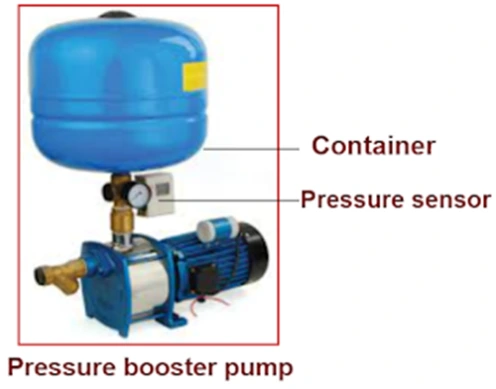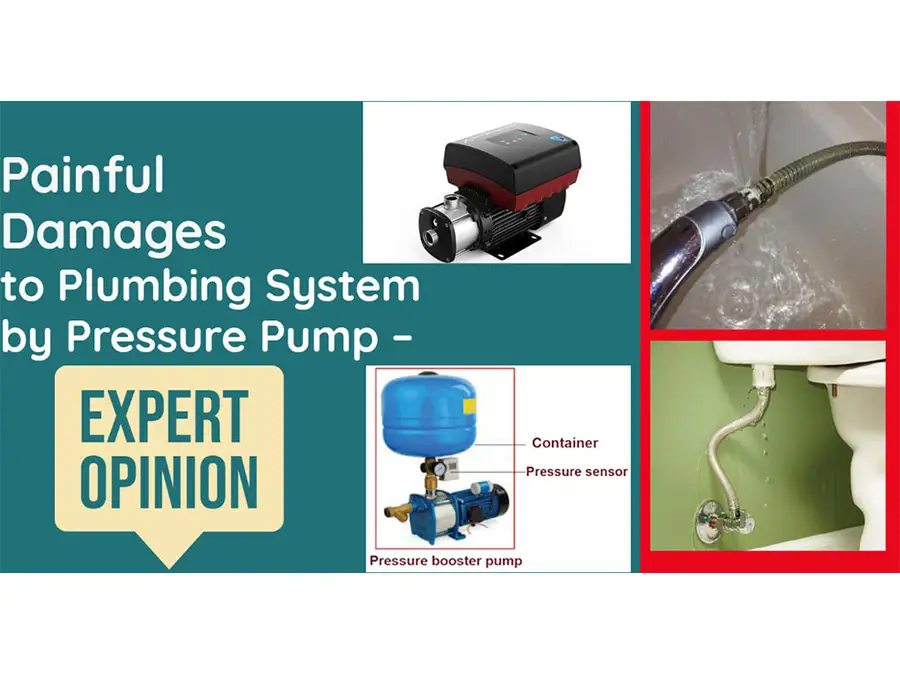If you already have installed an electric pump set for water pressure boosting in your house’ plumbing lines for an enjoyable bath under your modern rain shower or a massage shower, you are most likely facing damages to plumbing system. The problems would include bursting of connection hoses under the sink, Muslim showers break down very often, flush tank cistern giving up, threaded joints show signs of seepage etc. Such frequent failures of fittings might not be just because of poor quality of fittings or bad workmanship? The real culprit is within your home, not outside: Yes! It’s Your Pressure Pump.

Let us explain how it happens. You would need a little understanding as to how a pump works. You also need to understand why to have a pump at all. We have discussed all these details in our videos available on our YouTube channel (here is the link https://www.youtube.com/watch?v=aSrYsvGX74s).
The modern sanitary ware like showers, Jacuzzis, sink mixers etc. need sufficient pressure to operate appropriately. Besides, you may have a lawn which you may want to irrigate with automatic sprinkler system. Washing your car with less effort would also need pressurized water supply. All these fittings & fixtures need a minimum of 2 bars (approx. 29 PSI) of pressure at discharge point. To generate 2 bars of pressure under gravity, water must fall from a height of 20 meters (66 feet approx.). The overhead water storage tank in a 2 storey house is approximately 24-26 feet high because building bye laws limit the height of residential structures. Even if the building is higher than 24 feet, the pressure available under gravity will not be uniform at all the floors: closer you are to the overhead water tank, less pressure you will be getting. Therefore, it is not possible to have the required pressure under gravity alone. To generate uniform pressure on all the floors and all the taps you would need an electric pump.

How do you Select a Pump that Fits Your Specific Needs:
Well! this is a highly technical job which should be done by professionals but we will try to set the guide lines for you so that you do not pick a pump that is too big or too small. Lets first see how you calculate your flow requirements:
The table shown here explains the standard flow rate of various fittings usually used in residential buildings. You can count each type of fitting in your home and sum up the total flow rate that these fittings would need. For example, if you have 8 showers, you would need 2.4 liters/second (8×0.30=2.4) if all the showers are being used simultaneously. The same way you keep adding up all the fittings and you arrive at, say, 10 liters/second required flow rate. Since, all the fittings will never be in use simultaneously, you should take 25% of total calculated flow rate to be your peak flow at any given time. Therefore, your usual maximum flow requirement will be 2.5 liter/sec which means you need to select a pump that gives you 2.5 liter/sec flow @ 2 bars pressure; say 3 liters/second at 3 bars to keep magin for unusual situations.

Now look at the name plate data of the pump. The critical performance factors for you are its H-max and Q-max where H stands for the maximum pressure it can generate and Q stands for maximum flow it can generate. Please keep in mind that when the pump is giving its maximum flow; it is generating least amount of pressure. Therefore, take median of both the Q & H.
How a Pump Works?
The basic working principle of a pump is the same as that of a fan. A fan has blades which are curved at a specific angle. When the blades rotate at a specific speed, they slice a portion of air and throw it forward. The continuous motion of blades pushes the air into a specific direction: horizontal or vertical. The higher is the speed of fan, higher will be the flow rate of air.

Instead a water pump has an impeller which looks a little different than fan blades (it can be exactly like fan blades in some of the pump types). Continuous rotation of impeller generates a strong centrifugal force which throws water at long distances. Since pump is continuously pushing water into the confined passages (pipes), pressure builds up if water is not allowed to exit the lines or less quantity of water is being allowed to exit than the quantity that pump is pushing in.
Why your Pressure Pump May Damage Fittings?
An ordinary pump runs at a fixed speed (2900 or 1450 RPM) which means that the pump will always generate a fixed amount of pressure and flow. At any specific discharge point i.e. a tap, you are probably not drawing its entire generated pressure and flow but only part of it. The rest of the pressure & flow is being sustained by all the other faucets which do not require it if they are not functioning at that moment. When you close the tap under use, the pump does not turn off immediately but continues to build pressure in the lines until the pressure in the entire loop reaches a point at which the automatic pressure switch cuts off the electricity to the motor. Besides, pump will start at its full speed and turn off from its maximum speed. Such sudden start and shut down will generate excess pressure & turbulence in the lines. This is called ‘water hammering’ which is extremely damaging to your fittings which may not be designed to sustain the amount of pressure which water hammering generates. Normally, fittings are designed for 3-4 bars pressure whereas a pump which is designed for 6 bar pressure may generate a hammering force of 9 bars. The figures given here are for the sake of explanation which may not be precise.
Now that you understand the mechanism of pump’s working and the potential damage that it causes to your fixtures, let move to the next point.
The Damage Control:
The solution lies in controlling the speed of the pump so that it generates only the required amount of flow and pressure. Again the example of fan: you don’t run your ceiling or pedestal fan at the same speed always. A fan always comes with a ‘regulator’ or a fan dimmer. You would run your fan at a very high speed if you have to quickly dry up your wet floor but at relatively lower speed if you are sitting close to it or while the air conditioner is also working; thus adjusting its speed according to requirement of air flow. Something similar can be done with your pressure pumps also.
A similar device (regulator or dimmer) can be fitted with your pump’s motor that should control its speed, but it must not only be automatic but intelligent too for obvious reasons: somebody can’t sit with the pump all the time to keep altering its speed according to everybody’s needs in bathroom, kitchen and garden etc. But off course an intelligent microprocessor can perform this function on its own.
Variable Frequency Drive:
A Variable Frequency Drive (VFD) is an electronic apparatus that is integrated with a pressure sensor which is installed on the pipeline. It automatically senses the pressure in the pipelines and in response automatically alters its speed to reduce or increase pressure in the lines. Pressure requirement parameters are pre-set in the microprocessor which takes the input from pressure sensor and acts accordingly.

For example, when pump is in idle state, pressure is built in the pipes and being maintained due to ‘no- flow’ at any tap. When a tap is opened, pressure will drop in the pipe which will trigger a signal from the pressure sensor to microprocessor which will start the pump to maintain the pressure, say @ 2 bars. Pump will run, say, @ 750 RPM to meet the required flow and pressure. In the meantime, another tap is opened at another place, with increased flow the pressure will drop which will again trigger a signal in the pressure sensor. The microprocessor will ramp up the pump again @ say 1000 RPM. Whenever pressure drops beyond preset 2 bars, the VFD will increase the speed of the pump. Similarly, when the taps are being closed, VFD will slow down the speed of the pump and ultimately shut it down when there is no discharge in the line. The best thing about a VFD is that it starts the pump gradually and shuts down gradually eliminating its potential of generating water hammering. A VFD’s start up and shutting down processor is somewhat similar to a motor vehicle’s mechanism of gradual acceleration and ‘deceleration’.
VFD, however, is relatively expensive system and not so abundantly available especially for smaller size pumps of domestic usage. Its components can be purchased from the market and only an expert technician can fix it. Some pump brands are also offering packaged solution too.
If You Can’t Find or Can’t Afford a VFD:
Something still can be done to minimize the damages of ordinary pump. First of all, change the pressure switch. Mechanically programmable pressure switches are easily available (as shown in the picture). You can adjust and readjust the performance parameters of your pump by setting start up and shut down pressure on the switch. The optimal performance range is 1.5 to 3.5 bar i.e. the pump will start when pressure in the lines drops below 1.5 bar and it will stop when the pressure exceeds 3.5 bars.

Secondly, installing an air pressurized container in-line will greatly reduce water hammering and also reduce the frequency of start and shut down frequency of the pump. For every minor discharge of water from the line (filling a cup of water), the pump will not start because the pressurized air container will make up for the slight drop of pressure from the lines.
These measures will mitigate the over-pressurization of lines and reduce the damage to your expensive sanitary fittings but will not the problem entirely. The ideal solution is VFD. We sincerely hope that you will benefit from these guidelines in solving your problem. We can help if you need. Thank you.


